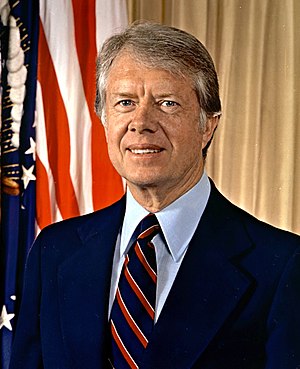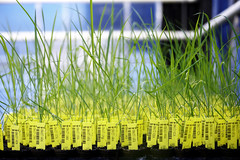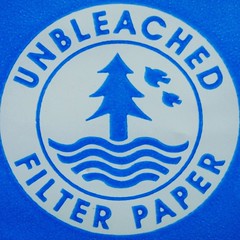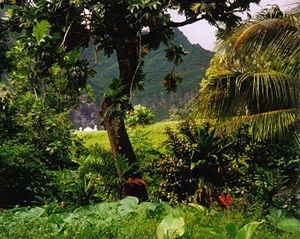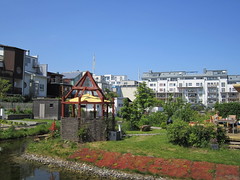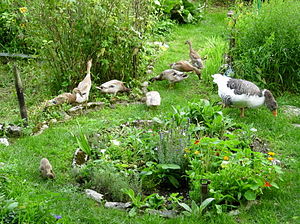 Image via Wikipedia
Image via WikipediaBy
George Shears
I have long argued that, in the broadest sense of the concept of addiction, ALL humans are addicted in multiple ways. Further, I have hypothesized that all of these addictions are mediated by common brain processes involving neurotransmitter substances such as dopamine, serotonin, epinephrine, etc, as well as by endorphins and enkephalins. This hypothesis has now been quite strongly confirmed for a wide range of addictions and compulsions.
During my career as a psychologist and psychotherapist, I constructed a loose working model for understanding the common psychological basis of all of these addictions and how they develop in terms of what I call "terminating reactions." I define a terminating reaction as any behavior that effectively reduces or terminates psychological discomfort for at least a short period of time. Each time that this occurs, the behavior acquires, through the process of "negative reinforcement," an increment of "habit strength" and thereby an increased probability of recurrence. Through this simple and well-established principle of learning theory, virtually ANY behavior can develop into a strong terminating reaction or "addiction."
The single most common category of such terminating reactions consists in what have been called "movement addictions." These highly repetitive, garden variety behavioral patterns can be observed in nearly everyone. They typically occur completely without awareness and most of them are generally benign. Examples include, foot jiggling, beard stroking, eye blinking, grimacing, toe tapping, hair twisting, idiosyncratic speech mannerisms, etc. Not uncommonly, they seem to express suppressed or repressed feelings.
For example, I have repeatedly observed a particularly recurrent movement addiction in a number of TV comedians. It consists in rubbing or scratching the cheek under one of the eyes or beside the nose, as if unconsciously wiping away a tear. I have often wondered whether these particular repetitive gestures may be understood as the unconscious surfacing of sadness or emotional pain that is being covered with humor.
In summary, then, terminating reactions are incredibly prevalent and highly varied. They include not only every conceivable form of behavior that is associated with increasing pleasure, through substances such as drugs and food, through exciting experiences such as sex, gambling, shopping, etc, but also-quite counter-intuitively-a wide range of behaviors that entail discomfort or pain-such as cutting or burning oneself, self-starvation, vomiting and the like.
There is now strong evidence that this sub-class of addictions is mediated in the brain by endorphins or "endogenous morphine" that is released whenever they occur. This happens automatically, for example, whenever someone engages in self-injurious behavior such as cutting, burning, head-banging, etc. The bottom-line result from such behavior, then, is temporary relief from psychological pain or discomfort, which has tragically become highly intense and nearly universal. So we humans have, indeed, ingeniously found endless ways to "spell relief."
One general class of addictions contributes directly and markedly to the destruction of our biosphere-namely, those entailing excessive consumption and consumerism. Not only are these addictions exceedingly common, but they are also actively engendered and strengthened by endless advertising and by our currently prevailing version of capitalism-a version, incidentally, that departs markedly from what Adam Smith originally proposed.
I hypothesize, further, that the epidemic of addictions that now afflicts us collectively grows lawfully out of the intense, chronic emotional distress that is inherent in our highly-alienated modern lifestyles. More specifically, I see this distress as an inevitable result of the pervasive sense of separateness that modern humans experience in relation to other beings, the biosphere, Mother Earth, and to the universe in general. I believe that, in large part, it comprises the collective human "pain body" that Eckhart Tolle often refers to as the basis of our common "human madness."
This enormous pain results basically from living in delusion; that is, we humans--just as is true of every other life form on this planet-are, in reality, seamlessly interconnected and inherently one with the entire biosphere and, in fact, with the whole universe. To believe deeply, as we do however, that we are intrinsically separate - and to behave accordingly - is effectively, then, a form of psychosis. Just as is true of all other forms of psychosis, this basic break with reality entails enormous suffering.
Referring to this delusion of separateness, Ken Wilber, who has been called "the Einstein of consciousness, says: "People typically feel trapped by life, trapped by the universe, because they imagine that they are actually
in the universe, and therefore the universe can squish them like a bug." He goes on to point out that if/when we become fully awakened to the vast emptiness of our Real Self, we realize that, as this Self, we actually
contain the entire universe instead of being
in it.
Acting out of this delusional sense of separateness, we humans relate to our extended body (the biosphere), in a manner that is remarkably similar to how cancer develops in our local bodies; that is, a key identifying characteristic of all cancer cells is that they stop communicating with the rest of the body and, thus, progressively grow out of control until they destroy the very body that they need to sustain them.
Viewed through this lens, then, it becomes abundantly clear that humanity is caught in a vicious circle whereby, as a direct result of our prevailing delusion of separateness, we are progressively destroying our extended biospheric body to the point where we are now in imminent danger of also being destroyed in the process. More specifically, this self-destructive process is occurring largely through our collective addictions, which arise in large part from the enormous chronic pain of our delusional separateness.
On the basis of this assessment, I have concluded that the only complete solution, or antidote, for the impending ecological catastrophe that we now urgently face is for at least a very large segment of humanity to awaken from its tragic delusion of separateness. My reasoning here is quite simple: If this were to happen, we would see very clearly that the biosphere is in fact none other than our extended body. With this clear recognition, we would then tend to relate to it protectively just as we normally do in relating to our local bodies (this assumes, of course, that we would also transcend the many addictive disorders that cause us to destroy our local bodies as well).
For the past year or so, I have dedicated myself, as have a great many other spiritually-oriented folks, to promoting this kind of awakening as fully as possible. Since I intentionally try to balance my idealism with realism, however, I recognize fully that this is - at the very least - an enormous undertaking and may, in fact, be almost as out of touch with reality as the primary delusion that it aims to overcome.
On a theoretical level, Ken Wilber argues very persuasively that the universe evolves lawfully, holistically, and multi-dimensionally through a nested series of wholes of increasing complexity, each of which includes and transcends its predecessor. The spiritual aspect of this has long been recognized in various wisdom traditions as the "Great Chain of Being". At the gross physical level, for example, sub-atomic particles become organized as atoms; atoms become organized as molecules; molecules become organized as life forms; and life forms increasingly become organized at ever-increasing levels of complexity.
Along with many other human development theorists, Wilber posits that humans are also subject to this very same kind of lawful process in their evolution. In this regard, he shows how, in a very general sense, human consciousness gradually develops from ego-centric to socio-centric to world-centric; that is, at the lowest level of consciousness, we are primarily focused on "I, me and mine"; at the next higher level, our consciousness includes others in our immediate family; then in our tribe; then in our nation state; then globally; and, ultimately, it includes all other beings and the entire universe.
Wilber estimates that about 70% of humanity is currently at the ethnocentric level of development-that is, strongly identified with other humans in their particular ethnic group; he estimates that only about 2% of the population is at the highest current level of development, which he calls world-centric or "integral". Not surprisingly, then, with regard to reversing our current ecological and global predicament. he concludes at the end of a very enlightening series of recent audios entitled,
Kosmic Consciousness, that our current situation is "very scary" and states that recurrent wars, with brief periods of peace, will likely continue to be the prevailing norm.
It seems quite clear, then that the development of world-centric consciousness is the minimally prescriptive antidote that we urgently need in order to survive. Although finding effective ways to promote development of this level of consciousness to humanity at large presents is overwhelmingly challenging, I intend to keep working at it in whatever way I can. Most importantly, this includes encouraging large numbers of other like-minded people to join in this monumental consciousness raising effort.
Ken Wilber reports that the single most effective way to accelerate the development of human consciousness to higher levels is through intense meditation or contemplative prayer. This is the particular means that I have personally applied and that I strongly recommend to others.
George Shears is a retired psychologist and a spiritual teacher/mentor. He has personally practiced mindfulness meditation for over 35 years and pioneered the first Mindfulness-Based Stress Reduction (MBSR) program in Minnesota, starting in 1995. He can be contacted at:
651-204-0523
gshears@arrowheadtel.net
http://www.wisewaystohappiness.com (where you can get a complete free set of MBSR audios and instructions for a self-guided course)
Article Source:
http://EzineArticles.com/?expert=George_Shears
http://EzineArticles.com/?Human-Alienation-and-Addictive-Behavior---How-They-Lead-to-Ecological-Destruction&id=6200192
 Image via WikipediaBy Barbara Colby
Image via WikipediaBy Barbara Colby








